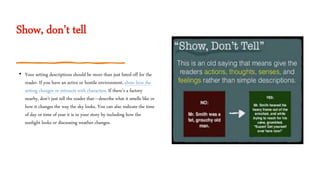Setting presentation
- 1. Setting Painting a picture with words.
- 2. Setting • The time, place, physical details, and circumstances in which a situation occurs. Settings include the background, atmosphere or environment in which characters live and move, and usually include physical characteristics of the surroundings.
- 3. Use Sensory Details • Use all five senses to describe the immediate surroundings to the reader to quickly immerse them in the environment of your story. The little details of how your marketplace smells, or what the wood of an old house feels like can make all the difference in your descriptive writing, and really set the stage for a vivid reader experience.
- 4. Show, don’t tell • Your setting descriptions should be more than just listed off for the reader. If you have an active or hostile environment, show how the setting changes or interacts with characters. If there’s a factory nearby, don’t just tell the reader that—describe what it smells like or how it changes the way the sky looks. You can also indicate the time of day or time of year it is in your story by including how the sunlight looks or discussing weather changes.
- 5. Use real-life locations • If you need inspiration, look at the setting around you. The old church down the road may not be what the religious center in your sci-fi novel looks like but using real locations as a basis for the ones you create can help outline the setting you’re going for. You can also use pictures and videos from places you cannot visit to get a general idea of what your own location would be like.
- 6. Incorporate Figurative Language • Your descriptions can be literal, but sometimes you can create a stronger image in the reader’s mind when using metaphors or similes to compare it to something else visual. For instance, comparing the volcanic eruption in your novel to a fiery, vengeful dragon can create intense imagery that will have more of an impact on your readers’ imaginations. • IMAGERY IS PERFECT FOR SETTING DESCRIPTIONS • PAINT A PICTURE IN THE READER’S MIND
- 7. Keep it simple • Focus on the details that really matter. • The importance of setting in a book should not be overlooked, however, it is also important not to go overboard. • A long list of what a place looks and feels like might feel thorough, but ten pages of scenery descriptions will be boring for the reader. • Choose the most interesting and vital details when describing the setting of your scene to give the reader a sense of balance, and not overload them with adjectives.
- 8. Examples • “The cold carved bone deep, fueled by the lash of the wind, iced by the drowning rain gushing from a bloated sky.” From The Dark Witch by Nora Roberts • “The lime green patio umbrella flapped happily in the breeze. It covered strawberry slushies, watermelon pies, and bright, cheerful stacks of donuts.” From Pink Lemonade and Cookies
- 9. One more example • My family, who consisted of me, my mother, father, and elder sister, lived in a Quonset Hut - austere quarters, thrown up quickly and by the thousands and without ceremony by Army engineers to house the incoming onslaught of warriors and their families. The buildings were made of corrugated, galvanized steel that were shaped like a tin can cut in half - a semi-circle of Army efficiency. They screamed grey, unlimited coldness. Insulation was a problem because the huts were placed on concrete slabs. Our home was the opposite of a Hobbit house where warm fires and colorful decor created a cozy, welcoming atmosphere. A place where bright flowers, lush grass covered roofs, and cobbled paths set in a landscape reminiscent of a scene from a Thomas Kinkade painting. Bitterly cold in the winter, swelteringly hot in the summer, my mother struggled to make these tin cans a home. From An Unfulfilled Life by Donna Moreau








